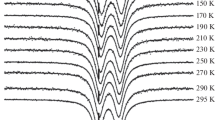Abstract
The Mössbauer fractions f for various ferrous- and/or ferric-containing oxides and oxyhydroxides, silicates and carbonates were evaluated from the experimental temperature dependence of their center shifts, using the Debye approximation for the second-order Doppler shift. It is concluded that ferrous ions exhibit a lower fraction as compared to ferric ions. Using standard mixtures of α-Fe2O3 with selected Fe2+ or Fe3+ compounds, it is found that the calculated Fe3+ f values are somewhat overestimated with respect to those of Fe2+. Possible explanations for this shortcoming are discussed and it is suggested that a different temperature dependence of the intrinsic isomer shift is the most likely reason. This suggestion is corroborated by analyses of hematite and hedenbergite data which are available for temperatures up to 900 K and 800 K respectively.
Similar content being viewed by others
References
Amthauer G, Annersten H, Hafner SS (1976) The Mössbauer spectrum of 57Fe in silicate garnets. Z Kristallogr 143:14–55
Bowen LH, De Grave E, Reid DA, Graham RC, Edinger SB (1989) Mössbauer study of a California Desert celadonite and its pedogenically-related smectite. Phys Chem Minerals 16:697–703
Chambaere DG, De Grave E, Vanleerberghe RL, Vandenberghe RE (1984) The electric field gradient at the iron sites in β-FeOOH. Hyperfine Interactions 20:249–262
De Grave E, Vochten R (1985) An 57Fe Mössbauer effect study of ankerite. Phys Chem Minerals 12:108–113
De Grave E, Vanleerberghe R, Verdonck L, De Geyter G (1984) Mössbauer and infrared spectroscopic studies of Belgian chloritoids. Phys Chem Minerals 11:85–94
De Grave E, Verbeeck AE, Chambaere DG (1985) Influence of small aluminum substitutions on the hematite lattice. Phys Lett A107:181–184
De Grave E, Persoons RM, Chambaere DG, Vandenberghe RE, Bowen LH (1986) An 57Fe Mössbauer effect study of poorly crystalline γ-FeOOH. Phys Chem Minerals 13:61–67
Dyar MD (1986) Comment on “Ferrous/ferric Mössbauer analysis of simulated nuclear waste glass with and without computer fitting”. J Am Ceram Soc 69:C160-C162
Ellwood BB, Burkart B, Rajeshwar K, Darwin RL, Neeley RA, McCall AB, Long GJ, Buhl ML, Hickcox CW (1989) Are the iron carbonate minerals, ankerite and ferroan dolomite, like siderite, important in paleomagnetism? J Geophys Res 94:7321–7331
Frauenfelder H (1963) The Mössbauer effect. W.A. Benjamin, New York, pp 1–336
Heberle J (1971) The Debye integrals, the thermal shift and the Mössbauer fraction. In: Gruverman IJ (ed) Mössbauer effect methodology, Vol 7. Plenum Press, New York, pp 299–308
Herber RH (1984) Structure, bonding, and the Mössbauer lattice temperature. In: Herber RH (ed) Chemical Mössbauer spectroscopy. Plenum Press, New York, pp 199–216
Karraker DG (1986) private communication
Kolk B (1984) Studies of dynamical properties of solids with the Mössbauer effect. In: Horton GK, Maradudin AA (eds) Dynamical properties of solids, Vol. 5. North Holland, Amsterdam, pp 3–328
Lafleur LD, Goodman C (1971) Characteristic temperatures of the Mössbauer fraction and thermal-shift measurements in iron and iron salts. Phys Rev B 4:2915–2920
Leider HR, Pipkorn DN (1968) Mössbauer effect in MgO:Fe2+; low-temperature quadrupole splitting. Phys Rev 165:494–500
Perkins HK, Hazony Y (1972) Temperature-dependent crystal field and charge density: Mössbauer studies of FeF2, KFeF3, FeCl2, and FeF3. Phys Rev B 5:7–18
Persoons RM (1990) Mössbauerstudie van de hyperfijnparameters in CoxFe3-xO4, 0<x<0.6, in het temperatuurgebied boven de verweytransitie. PhD Thesis, Gent State University, p V-10
Pound RV, Rebka GA Jr (1960) Variation with temperature of the energy of recoil-free gamma rays from solids. Phys Rev Lett 4:274–277
Seifert F, Olesch M (1977) Mössbauer spectroscopy of grandidierite, (Mg,Fe)Al3BSiO9. Am Mineral 62:547–553
Vandenberghe RE, Verbeeck AE, De Grave E (1986) On the Morin transition in Mn-substituted hematite. J Magn Magn Mater 54–57:898–900
Vandenberghe RE, De Grave E (1989) Mössbauer effect studies of oxidic spinels. In: Long GJ, Grandjean F (eds) Mössbauer spectroscopy applied to inorganic chemistry, Vol 3. Plenum Press, New York, pp 59–182
Author information
Authors and Affiliations
Rights and permissions
About this article
Cite this article
De Grave, E., Van Alboom, A. Evaluation of ferrous and ferric Mössbauer fractions. Phys Chem Minerals 18, 337–342 (1991). https://doi.org/10.1007/BF00200191
Received:
Accepted:
Issue Date:
DOI: https://doi.org/10.1007/BF00200191




